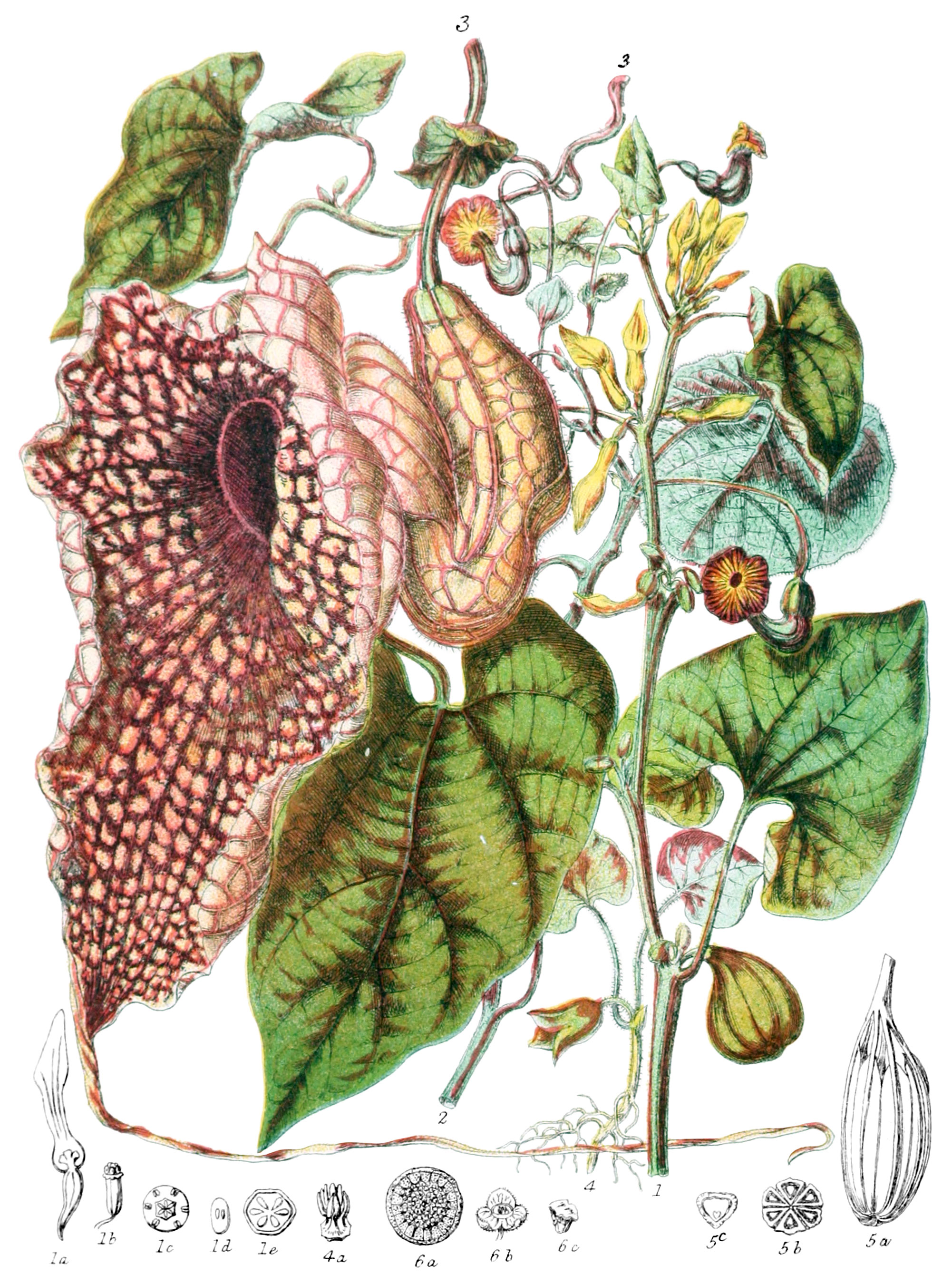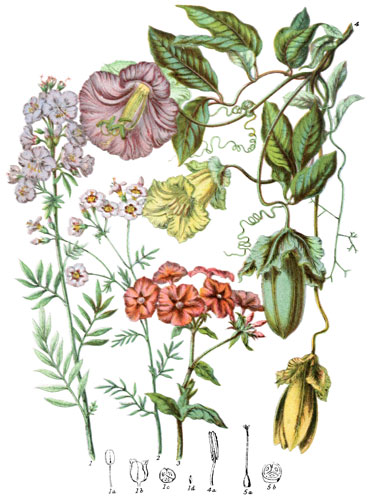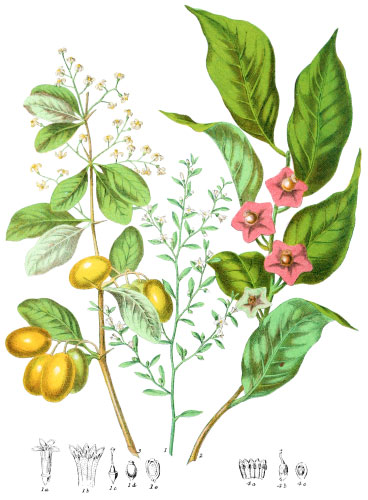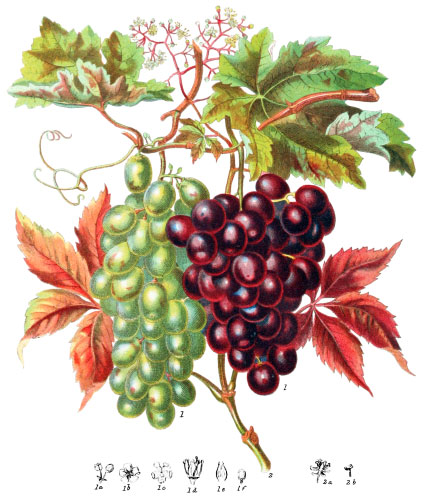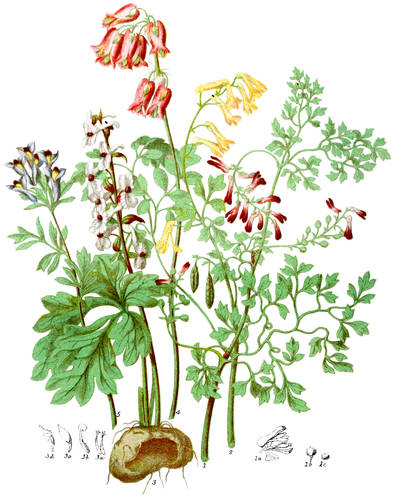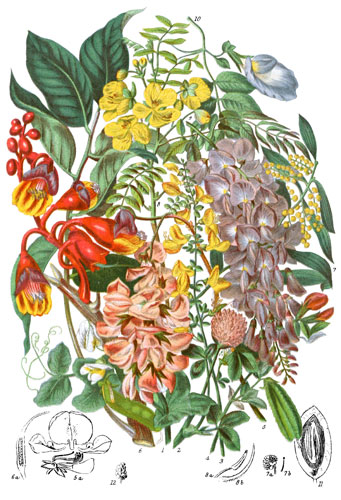Key characteristics
Herbaceous plants and shrubs, some of which are climbing. The wood is without concentric zones and inseparable wedges. The leaves are alternate, simple, stalked, often having a scaly or leafy stipule. The flowers are solitary from the base of the leaf-stalk, usually brown or some dull colour. The calyx is adherent, tubular, regular, or unequal. The stamens are six to twelve, placed upon the calyx, distinct, or adhering to the style and stigmas. The ovary is inferior, six-celled, rarely three or four-celled, the style is single, the stigmas radiating, as numerous as the cells of the ovary. The fruit is dry or succulent, three, four, or six-celled, many-seeded. The seeds are thin, angular, or round, containing fleshy albumen.
This Tribe has very slight affinity with any other.
Tonic stimulating properties exist in the roots and leaves of these plants.
Select plants in this order
Not all plants listed are illustrated and not all plants illustrated are listed.
- Aristolochia and its allies may be said to form a kind of link between the two great classes of the vegetable world, the dicotyledonous and the monocotyledonous plants, having the chief points of structure of the former, and agreeing with the latter in the ternary arrangement of the parts of the flower and the incomplete formation of the wood. The flowers of this genus exhibit a remarkable diversity fo shape and colour, and strange deviations from the regular typical form of a simple corolla; the contrast between the little yellow English species and the large and extraordinary developments of hotter regions, is amongst the most curious to be found in the whole range of the floral world.
- A. Clematitis (1) is so rarely discovered in a wild state in England that it can scarcely be reckoned an original native, but rather a naturalized foreigner, become indigenous only in a few localities where it was formerly cultivated. The site of the garden of the old nunnery of Godstow, near Oxford, is one of the few situations where it is to be seen. The roots are considered to have powerful medicinal properties, like those of the exotic species.
- A. Sipho (2) is one of the tallest species, and well adapted for covering arbours, making a pleasant shade with its large and numerous leaves. The flower shows a regular ternary division, and is among the simple forms.
- A. gigas (3) affords a striking object to an European traveller in the forests of Guiana, climbing over shrubs, with its fine leaves and remarkable flowers; the latter may be frequently seen on the heads of little native children, worn as a cap in sport.
- Some of the Brazilian species rank amongst the most powerful in the properties of the roots, which have generally a strong disagreeable scent, and a bitter aromatic flavour.
- A. ringens, A. galeata, and others, are of much value in the medicines they yield.
- A. fragrantissima, the Star-reed of Peru, is one of the medicinal plants of that country.
- A. trilobata and A. odoratissima afford medicine to the natives of Jamaica.
- The dried fibrous root of A. serpentaria is used in North America to cure the bite of snakes, and is imported into Europe, where it still retains a place as an available medicine.
- A. anguicida is supposed to be the celebrated Guaco mentioned by Humboldt. Several kinds grow in Egypt, and are there employed by the famous jugglers to stupefy snakes. India has also a portion of these singular plants, and Hindoo doctors prepare infusions of the leaves and various remedies from the roots.
- A. saccata, on the mountains of Silhet, grows to the height of twenty feet, and has leaves more than a foot in length, and four inches wide; the numerous flowers are suspended in a vertical position on a kind of panicle.
- A. cymbifera and A. labiosa have both curiously expanded lips to their flowers.
- A. ciliata, of Patagonia, has the small flower fringed with long glandular hairs: but to enumerate the countless variety of form assumed by this eccentric genus would be impossible.
- Asarum europæum (4) is only occasionally found in hilly woods in the northern counties; near Kirkby Lonsdale is most plentiful, and is of peculiar appearance with its two leaves and solitary flower. The creeping roots have medicinal properties. Although India possesses so many powerful medical plants, yet this little European species is sold in the bazaars under the name of asaroon.
- Bragantia (6)* shows the peculiar formation of the wood of this tribe.
- B. tomentosa is an extremely bitter plant of Java: some species are natives of India and the Malay Isles.
Locations
This Tribe is very abundant in the Tropics of South America, frequent in the north of Africa, rare in North America, Europe, and Siberia, existing only in a few species in India. Asarum belongs equally to North America, Japan, and Europe.
Legend
- Aristolochia Clematitis, Common Birthwort. England.
- Section of Flower.
- Ovary and Stamens.
- Stamens and Pistil.
- Anther.
- Section of Ovary.
- Aristolochia Sipho, Broad-leaved Aristolochia. Philadelphia.
- Aristolochia gigas, Gigantic Aristolochia. South America.
- Asarum europæum, Common Asarabacca. England.
- Stamens and Pistil.
-
- Capsule of Aristolochia.
- Section of Seed-vessel.
- Section of Seed.
-
- Wood of Bragantia.
- Flower.
- Seed.
*6 was mentioned in the original description but only 6a–6c were illustrated.
Explore more
Posters
Decorate your walls with colorful detailed posters based on Elizabeth Twining’s beautiful two-volume set from 1868.
Puzzles
Challenge yourself or someone else to assemble a puzzle of all 160 botanical illustrations.
